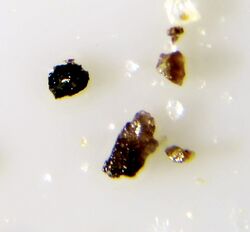Chemistry:Hafnon
From HandWiki
| Hafnon | |
|---|---|
 Very small brown single crystals of hafnon from Bernic Lake, Lac-du-Bonnet District, Manitoba, Canada | |
| General | |
| Category | Nesosilicates |
| Formula (repeating unit) | Hafnium silicate (HfSiO4) |
| Strunz classification | 09.AD.30 |
| Dana classification | 51.05.02.02 |
| Crystal system | Tetragonal |
| Crystal class | Ditetragonal Dipyramidal (4/mmm ) H-M symbol: (4/m 2/m 2/m) |
| Space group | I41/amd |
| Unit cell | a = 6.5725(7) Å, c = 5.9632(4) Å=; Z = 4 |
| Identification | |
| Colour | Orange-red,brownish yellow, rarely colourless |
| Crystal habit | Euhedral to irregular crystals |
| Cleavage | {???} Indistinct |
| Mohs scale hardness | 7.5 |
| |re|er}} | Vitreous |
| Streak | grey white |
| Diaphaneity | Transparent |
| Density | 6.97 |
| Optical properties | Uniaxial (+) |
| Refractive index | nω = 1.930 - 1.970 nε = 1.980 - 2.030 |
| Birefringence | δ = 0.050 |
| Common impurities | Often zoned with zircon. Forms part of zircon-hafnon series |
Hafnon is a hafnium nesosilicate mineral, chemical formula (Hf,Zr)SiO
4 or (Hf,Zr,Th,U,Y)SiO
4.[2] In natural zircon ZrSiO
4 part of the zirconium is replaced by the very similar hafnium and so natural zircon is never pure ZrSiO
4. A zircon with 100% hafnium substitution can be made synthetically and is hafnon.
Hafnon occurs as transparent red to red orange tetragonal crystals with a hardness of 7.5.[3][4]
Hafnon occurs naturally in tantalum-bearing granite pegmatites in the Zambezia district, Mozambique and in weathered pegmatites at Mount Holland, Western Australia.[5] It has also been reported from locations in Ontario, Quebec and Manitoba, Canada; North Carolina, United States; and in Zimbabwe.[3]
References
- ↑ Warr, L.N. (2021). "IMA–CNMNC approved mineral symbols". Mineralogical Magazine 85 (3): 291–320. doi:10.1180/mgm.2021.43. Bibcode: 2021MinM...85..291W.
- ↑ http://www.minerals.net/mineral/silicate/neso/zircon/hafnon.htm Minerals.net
- ↑ 3.0 3.1 http://www.mindat.org/min-1792.html Mindat
- ↑ "Hafnon Mineral Data". http://webmineral.com/data/Hafnon.shtml.
- ↑ http://www.handbookofmineralogy.org/pdfs/Hafnon.PDF Handbook of Mineralogy
- Emsley, John. Nature's Building Blocks. Oxford, 2001. ISBN:0-19-850341-5
- J. A. Speer, B. J. Cooper (1982). "Crystal structure of synthetic hafnon, HfSiO4, comparison with zircon and the actinide orthosilicates". American Mineralogist 67: 804–808. http://www.minsocam.org/ammin/AM67/AM67_804.pdf.
 |

